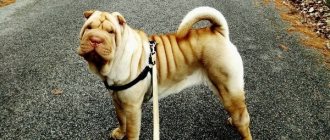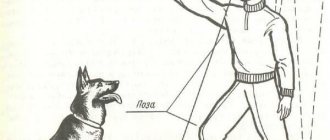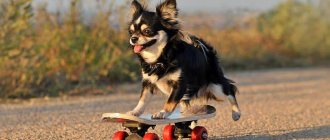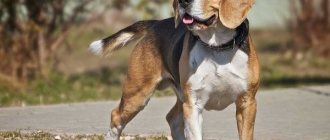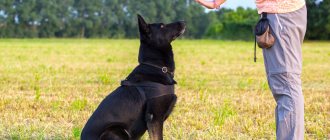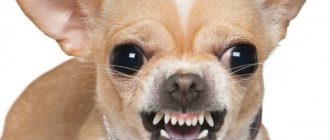Among the distinctive features of Chihuahuas is their tendency to dominate and the desire to take a dominant position in the family.
That is why it is necessary to take a responsible approach to training and education and teach your pet the correct behavior. This is a prerequisite for keeping a Chihuahua.
Otherwise, he will begin to dominate, which will result in a lot of problems for the hosts.
Are Chihuahuas trainable?
Chihuahuas are smart and quick-witted dogs originally from Mexico , capable of quickly remembering commands .
The main difficulties that may arise during the training process are associated with the nature of the Chihuahua - with the natural stubbornness, self-will of representatives of this breed and their refusal to follow commands.
Therefore, the owner must show patience and perseverance, develop a training system and adhere to the step-by-step training of the pet with the necessary commands and rules of behavior..
Questions and answers
What is the character of a Chihuahua?
Chihuahuas are extremely curious, but quite patient. By temperament they are very active and restless. They easily understand what mood the owner is in. Chihuahuas have a fairly high level of intelligence. Dogs of this breed are savvy, think quickly and react to stimuli. They are easy to socialize and love to play with their owner.
Brief characteristics of the Chihuahua breed
The breed is easy to recognize: a small, fragile body with thin limbs, large protruding ears and a funny “deer” face. Other external features include wide open and slightly protruding eyes and rounded ribs.
At what age should you start?
You need to start training a Chihuahua from the first days the puppy appears in the house, i.e. at about 2 months.
This will allow you to achieve positive results in the shortest possible time, because at this age, the pet is able to quickly remember its name, master a set of basic commands, get used to hygiene procedures (including brushing teeth) and understands the owner’s emotions well, distinguishing between dissatisfaction and praise.
It is possible to instill the basics of correct behavior and teach basic commands to an adult dog, but it is somewhat more difficult to do this due to its formed character and established habits..
Properties of temperament
Chihuahuas are less prone to cowardice, hysterics and sudden mood swings than other toy breeds. These dogs behave with dignity, they are majestic and courageous, despite their tiny size, however, they can be somewhat arrogant and headstrong.
Chihuahua owners note that the temperamental characteristics of their pet are related to the type of breed it belongs to.
Thus, long-haired dogs are distinguished by a softer, calmer and friendlier disposition, while smooth-haired dogs are more active, emotional and can be vicious towards strangers or strange dogs.
Where to start education?
You need to start learning with the simplest things. It is important to teach your pet to recognize the owner’s voice and the intonation with which words are spoken - the Chihuahua must understand when he is being scolded or praised.
To do this, you need to accompany the words with facial expressions and a change in timbre.
NOTE!
So, a stern facial expression and a stern voice will indicate bad behavior to the dog, and a soft, quiet tone and gentle stroking will make it clear that everything is fine.
You need to accustom the puppy to the nickname, for which you should often pronounce it in a calm voice, calling your pet to you or offering him food or a treat. All this contributes to the development of positive associations associated with the name, so the dog will respond and come to the owner without fear.
If the Chihuahua has done something wrong and needs to be punished, you should avoid pronouncing the nickname.
From the first days, it is necessary to set the boundaries of what is permitted and strictly adhere to them - for example, if the dog is not allowed to sleep on the sofa, then you should not allow it to do so even occasionally.
Expert opinion
Kozhevin Semyon Kirillovich
Expert dog handler.
The common belief that a dog needs to be trained after it is six months old is incorrect. Most often, the fears of Chihuahua owners regarding the early start of classes are caused by the fear of creating a stressful situation for the pet, which could affect its psyche. But this is only possible when using harsh methods, including physical punishment. The modern approach to raising a dog is based primarily on establishing contact and trusting relationships with the animal, which not only will not harm him, but will also help him quickly settle into a new home, successfully socialize and lay the foundations for proper psychological development.
How to toilet train?
Using absorbent diapers as your dog's litter box is an easy way to keep your home clean.
To train your pet to relieve itself in the right place, it will take some effort.:
- you need to take your dog to a diaper immediately after waking up and every feeding;
- if possible, you should limit the puppy’s free space and place one or more diapers in a designated area - this will minimize the likelihood that he will get confused and shit near the toilet;
- if the pet is not limited in moving around the apartment, it is necessary to put diapers in several places at once and gradually reduce their number.
You can also spray special sprays on the diaper or leave small rags on them; if you first blot the puddle with them, the dog will smell the smell and understand that this is a toilet.
Behavior on the street
The basics of proper outdoor behavior should be taught to an adult dog in the same way as a puppy. The only difference is that this will take a little more time, because the adult has already formed his character and has ingrained habits.
At first, you should only walk your dog on a leash and carefully monitor what it is doing - for any attempt to eat something or show aggression towards other animals or people, you must use the command “Ugh!”.
Playing with other animals also contributes to getting used to the street. Dogs are social creatures and often learn basic behaviors from each other.
If your pet refuses to go to the toilet outside and only sniffs everything during a walk, you should increase the duration of walks and diversify them with active games.
This way, the dog will quickly waste energy and will not wait to get home, but will relieve itself outside, after which it must be praised and treated with a treat.
Read about whether a Chihuahua needs clothing for walks here.
How to stop biting and why dogs can be angry
Most often, the reasons that a dog bites are related to its desire to protect itself and are caused by:
- the owner’s unfaithful behavior and his attempt to achieve obedience through physical punishment;
- the pet’s desire to take the main place in the family;
- jealousy;
- mental disorders;
- self-doubt.
A puppy, without controlling the force of its bite and not realizing that this is prohibited, can bite its owner during play, and in such a situation it is important to prevent such behavior from becoming a habit.
How to proceed:
- You should not hit a pet if it has bitten the owner unintentionally - this will aggravate the situation, provoking aggressive behavior;
- when a puppy bites consciously, showing aggression, it is necessary to use the command “Fu!” and lightly slap him on the rump;
- If a Chihuahua bites during play, you should interrupt the activity and give the animal time to calm down and realize what caused the cessation of fun.
A clear definition of roles within the family will help to avoid the formation of the wrong habit - the dog must understand from the first days that it is not a leader.
If the moment is missed and biting has become a dog’s habit, it is necessary to devote maximum time to correcting this behavior and, possibly, contact a professional dog handler.
Proper dog care
Activities for caring for a Chihuahua include the following:
- trimming nails using a nail clipper;
- cleaning eyes and ears. To do this you will need cotton pads and special lotions;
- weekly brushing;
- every six months it is necessary to worm your pet;
- you need to bathe three to four times a year;
- Walk the dog two to three times a day. You need to choose quiet and uncrowded places where the baby will feel relaxed and safe.
Chihuahuas finally stop growing at 8 months. Therefore, its feeding is carried out according to the “adult” scheme:
- Protein is a key component of the entire diet. The daily adult norm for sneezing is at least 80 grams for every kilogram of the dog’s weight.
- Since Chihuahuas have a tendency to rapidly gain weight, it is recommended to give them wet food that is low in calories.
- Do not give salty, fatty or fried foods under any circumstances. This harms your pet's kidneys and liver.
Basic Commands
| How to master | Team |
| "Ugh!" | This command should be used if there is a need to prohibit your pet from doing something: showing aggression, trying to bite, wanting to eat something on the street, etc. It must be pronounced loudly, in an angry voice, accompanying the words with appropriate facial expressions and stamping of the foot. You should not reward your puppy with treats or praise after performing this command. |
| "Sit!" | You need to let your dog sniff the treat and raise your hand with the treat so that he can only see it from a sitting position. If the pet does not sit down, you can lightly press on its croup and clearly, in an orderly tone, say “Sit!” After completing the command, you need to praise the Chihuahua and treat it with a treat. |
| "Lie!" | Training is similar to the “Sit!” command: you need to lower your hand with a treat and, by lightly pressing on the body or pulling the collar, force the dog to lie down, then praise and give a treat |
| "To me!" | The command tone used to pronounce this command should be accompanied by some sound, such as clapping your hands. You cannot use a command to scold your pet afterwards - this will serve to develop negative associations, and the dog will not come on command |
| "Place!" | A command that is useful if your pet’s behavior causes dissatisfaction. The stern voice used to pronounce this command should be accompanied by pointing a finger in the appropriate direction. At first you need to push the dog, but over time there will be no such need |
| “Give me your paw!” | When teaching this command, the role is played not by intonation, but by the pet’s visual memorization of the owner’s gesture. |
Encouraging behavior
An angry dog is not a happy dog. Yes, it can be quite funny to watch a tiny ferocious ball of fur run around the house chattering madly, barking, growling and generally acting like he rules the roost, but it's actually not in your pup's best interest.
The buildup of stress he experiences when he gets angry is unhealthy and can cause long-term health problems for your Chihuahua. The anxiety he feels when he's angry can also trigger a variety of other bad behaviors, such as urinating frequently in the house, tearing things to shreds, or causing him to have panic attacks where he's out of breath and shaking. These are all things that are best avoided if possible.
A Chihuahua that gets angry is still an angry dog. Chihuahuas have quite sharp teeth, and they know how to use them. A bite from a Chihuahua, even if its mouth is small, can be extremely painful. Even a small bite is very unpleasant. If you have visitors and your Chihuahua just happens to bite one of them or anyone who comes into the house, such as a delivery person, as ridiculous as it may sound, you could be facing a lawsuit.
© shutterstock
Training by month
| Age | Education |
| 2 months | The puppy does not yet have all the necessary vaccinations and you cannot walk him outside, so all training takes place at home. At this age, the Chihuahua needs to be taught to go to the toilet in a certain place and respond to its nickname. It is also necessary to accustom him to a collar and leash so that they do not become an additional source of stress for him when he first finds himself outside. It is important to clearly indicate what can and cannot be done to your pet and not allow him to go beyond what is permitted. In addition, you should start teaching basic commands, doing it in a playful way and rewarding the puppy for correct execution. |
| 3 months | You can begin to introduce the dog to the outside world. The first walks should be short and of an introductory nature. During this period, the pet’s nervous system is formed, so walks should not be limited to the nearby territory. It is important to show the Chihuahua as many different places as possible, introduce it to other people and animals - this will help strengthen the pet’s psyche and avoid stressful situations in the future. When training, you should adhere to the same principles - it is best to train a puppy in the form of play and not physically punish him. |
| 4-5 months | The puppy has already become comfortable at home and outside and can begin full training. During training, the owner should be more persistent and demanding, but, of course, within reason. At this age, a Chihuahua puppy should know the commands “Sit!”, “Lie down!” and “Ugh!”, stop barking at the owner’s request and be sure to immediately come to the command “Come to me!” |
| After 6 months | Puberty is associated with changes in the character and behavior of the dog - a Chihuahua can be disobedient and deliberately do things that are forbidden to it. It is important not to allow him to do this, otherwise the pet will decide that such behavior is normal. You need to correct the animal’s behavior confidently and firmly, but displaying anger and physical punishment are still prohibited. |
Bitch: character
There is an opinion that Chihuahua bitches have a more submissive and gentle character. But experts believe that character largely depends on heredity and individual characteristics. There are always exceptions, bitches with a very difficult character, and there are males with an easy-going and submissive character. But still, there is a difference in the behavior of the sexes. There are advantages and disadvantages for female and male genders.
Advantages:
- Strong relationship with owner and home
- Emotionally sensitive perception
- Girls are smarter and smarter than boys
- Accepts training tasks well
- During walks, he runs less in the bushes
- Doesn't rush at strangers
- The breed is ideal for breeding, just one assessment from the exhibition is enough
Flaws:
- Sly
- Periodic menstruation
Basic mistakes in parenting
If we are talking about an inexperienced breeder, then mistakes when raising a dog are inevitable.
The most common ones include:
- training in a noisy place - loud extraneous sounds that prevent the dog from hearing the owner well and distracting it from training must be excluded;
- screaming and physical punishment - the main task of training and education is to establish contact and trust between the pet and the owner, so dissatisfaction must be expressed differently;
- feeding before exercise - you cannot train immediately after eating;
- lack of positive reinforcement - the puppy must be rewarded with a treat or praise after following a command.
CAREFULLY!
The main mistake in dog training is lack of regularity.
Unsystematic training will not bring the desired result.
Negative
- Monogamous people: they tend to become attached to only one person in the family.
- They may become jealous of the owner's other pets or even children.
- They are very touchy and do not tolerate rough treatment.
- The increased emotionality of these dogs sometimes leads to uncontrolled urination in Chihuahuas in stressful situations.
- They need an individual approach to training.
- With improper upbringing or its complete absence, these dogs can turn into real domestic tyrants: stubborn, disobedient and even biting.
Bad habits of Chihuahuas and how to deal with them
We love these cute Chihuahua dogs for their beautiful faces and beautiful appearance, which makes many melt before our eyes. However, even these beautiful creatures are not alien to some whims and bad habits, from which they should be weaned. After all, if at an early age the Chihuahua is not trained and taught everything necessary, then instead of a cute dog we will get a harmful and capricious dog. And it is unlikely that you, as the future owner of a Chihuahua, would like to have a naughty pest, gutting everything in its path and leaving behind unpleasant marks.
We tried to find Narcissa another family.
Desperate to re-educate the dog, I even tried to find Narcissa another family. I really wanted the dog to have an owner who would spend a lot of time with him, take care of him, play with him, teach him, and dote on him.
And one day... we gave it away. But after 1.5 months Narcissus returned to us. He refused to eat, was bored, and also shit.
He came back and continues to dirty our sofa. We go crazy and he enjoys it. How to wean him off?
But recently we found a way out. When we leave, we cover the sofa with diapers and fill it with toys so that the dog doesn’t sneak in. It helps for now, but for how long? This is a very inventive creature!
Breed standard
- Weight : from 0.5 to 2 kg. If the weight is higher, the dogs will be disqualified.
- Height at withers : from 15 to 23 cm.
- Color : The predominant colors are: white, brown-black, dark brown, chocolate, fawn. Other colors and their mixing are also acceptable in the breed.
- Coat : Chihuahuas are divided into short-haired and long-haired. This, in principle, is the difference in the breed.
- Body type can also be divided into two types:
- Cobby-type. Dogs of this type are characterized by a dense, heavy and stocky build;
- Deer-type. Unlike the cobby-type, here the characteristic features of the body are lightness, high thin legs, elegance, and gracefulness, similar to that of a deer.
- Country of origin : Mexico.
- Age : with proper and good care, Chihuahuas live up to 20 years.
Cobby-type
